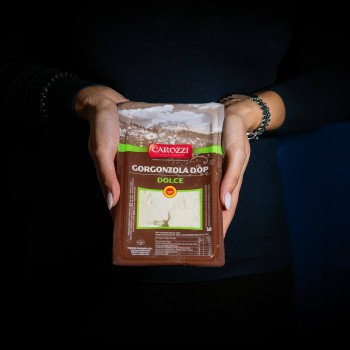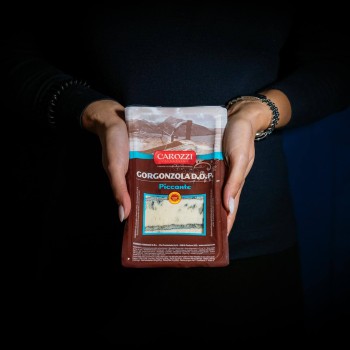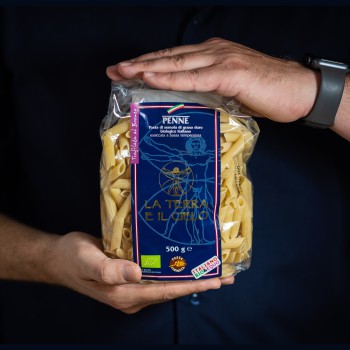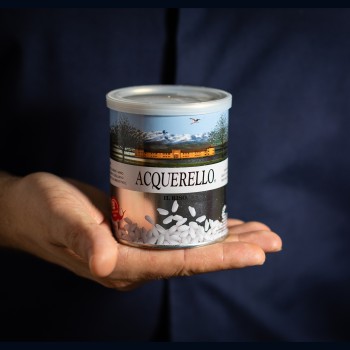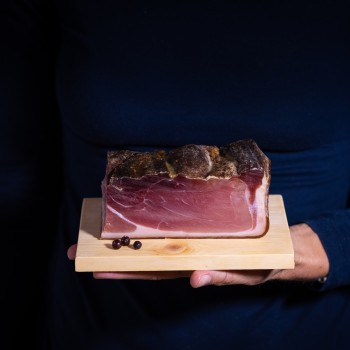- Meat & Seafood add remove
- Cured meats & Cheeses add remove
- Pasta & Pizza add remove
- Preserves & Condiments add remove
-

- Pickles & Preserves add remove
-
- Truffles, legumes & mushrooms add remove
- Desserts & snacks add remove
- Organic
- Tasting Selections
- Christmas
- Regali aziendali
- Brands
- Meat & Seafood add remove
- Cured meats & Cheeses add remove
- Pasta & Pizza add remove
- Preserves & Condiments add remove
-

- Pickles & Preserves add remove
-
- Truffles, legumes & mushrooms add remove
- Desserts & snacks add remove
- Organic
- Tasting Selections
- Christmas
- Regali aziendali
- Brands
PDO Gorgonzola cheese
PDO Gorgonzola cheese, the most famous cheese from Lombardy
Gorgonzola is a blue cheese with raw paste, made from whole cow’s milk. It is made in Brescia, Pavia, Novara, Biella, Varese and Lecco, in an area located in between the regions of Lombardy and Piedmont. In 2019 Gorgonzola cheese production exceeded 5 million cheese wheels, making it the third most popular Italian cheese. Gorgonzola cheese export is also continuously rising, first of all within the European Union, followed by Japan and the USA.
PDO Gorgonzola cheese, mild - 200g
PDO Gorgonzola cheese, spicy - 200g
The brand we selected:
.jpg)
History of Gorgonzola cheese
Gorgonzola cheese was born in - you guessed it! - the city of Gorgonzola, in the province of Milan. A Gorgonzola cheese festival is held there in the month of September every year, when selected exhibitors, artisans and enogastronomy experts gather to celebrate this local delicacy.
We don’t know when it was created exactly; some people say it was around 879, other people reckon that Gorgonzola was actually created some centuries later. What’s sure is that Gorgonzola cheese was born by chance.
Legend has it that a herdsman mixed some cold curd from the previous evening with the lukewarm curd obtained that very morning. We will never know how he came up with that idea, but a couple of days later a cheese with green veins and a terrible smell, but an incredible flavour, was born. The herdsman had had an epiphany. The secret behind this cheese is the presence of moulds; nowadays, these moulds develop as the result of Penicillium spores which are added to the cheese in a controlled manner.
Up to the 19th century Gorgonzola cheese was only popular at local level. Then it started to be exported first of all to other Italian regions, then to England, where another blue cheese was quite popular at the time: Stilton cheese.
In the post-war period, a new processing technique was developed, which was more hygienic and didn’t require the use of two different curds anymore; only one curd was used, to which spores and yeasts were added to trigger mould growth. And ever since that moment, Gorgonzola cheese production has never stopped growing, reaching staggering figures in the past years.
In 1951 the top European cheese-makers met in Stresa, where they signed an agreement on the protection of traditional cheeses. In 1954 the Italian Parliament passed a law to safeguard the designations of origin of the main traditional Italian cheeses. The following year, the first cheeses were recognised and protected: Gorgonzola cheese came right after Parmigiano Reggiano and Grana Padano.
In 1970 the Gorgonzola cheese consortium was founded in Novara with the aim of safeguarding and monitoring this cheese, as defined by a ministerial decree. The consortium must in fact check that Gorgonzola cheese is made according to its product specifications; moreover, it sets some guidelines for its marketing and states that Gorgonzola cheese must have:
- a cylindrical form, with a total diameter ranging between 20 and 32 cm
- a straight heel, at least 13 cm tall
- a fat in dry matter percentage of around 48%.
Since 1975 Gorgonzola cheese has been branded with a blue bold G letter which is still today the seal of guarantee of this excellent product.
Gorgonzola cheese obtained the Protected Designation of Origin in 1996. This means that every step - from milk production, to processing, to packaging - must occur only within the defined geographical area. The PDO label also includes product specifications that must be strictly followed, failing which the label shall be revoked. It is forbidden to add any milk other than cow’s milk, as well as other ingredients, such as red hot chilli pepper, saffron and nuts.
How is PDO Gorgonzola cheese made?
The PDO Gorgonzola cheese production is rather complex and consists of several steps. Whole cow’s milk is put in a boiler and pasteurised.
It is a cheese with a raw paste, and it is heated in a boiler whose temperature does not exceed 32 °C. The “usual” starter cultures are added, as well as selected spores of the Penicillium Roqueforti species, which trigger mould growth. Liquid calf’s rennet is also added and we wait for the milk to turn into curd. The curd is then broken into little cubes and excess whey is removed.
Once it’s ready, the curd is pulled out with the help of cloths and put in special stainless steel moulds to drip out. The final steps of draining and shaping occur in these moulds, to be followed by salting - only with Italian sea salt.
Then it’s time to steam the cheese; the cheese is left in a “hot chamber” at a controlled temperature of 21 °C for 24 hours. It is then salted for a second time and it is left to rest once again in a hot chamber.
The aging step, which takes place in cold cellars at a temperature ranging between 3 and 5°C, begins now. Then another fundamental step: piercing. The cheese is pierced with steel needles to activate the marbling process. As a matter of fact, the oxygen entering the holes prompts the natural growth of moulds.
After another salting step, the cheese is left to age one more time: at least 50 days for mild Gorgonzola cheese and at least 80 days for spicy Gorgonzola cheese.
Mild or spicy?
Gorgonzola is a high-fat cheese with a characteristic flavour and a signature scent. There are two types of Gorgonzola: mild and spicy. The only difference lies in the aging period: the longer the cheese ages, the more intense will its flavour be.
The most popular Gorgonzola is mild Gorgonzola cheese. It is creamy and melts in the mouth and it has a sweet, velvety flavour. The paste is soft, white to straw yellow with green speckles. The marbling is evident, but not too overpowering. The rind has a rough and wrinkly surface and it is moist and non-edible. The flavour is definitely more delicate than the flavour of spicy Gorgonzola cheese which is stronger and more robust.
Spicy Gorgonzola paste is crumbly and compact; when the cheese is a little bit more mature, the paste is almost chalky. The colour is ivory white with many bluish stripes. The flavour is intense, spicy, sapid and pungent. The aging period makes the flavour more intense; that’s why this cheese may not be to everyone’s taste.
There also are reserve Gorgonzola cheeses which age up to two hundred days. They are for gourmets and have a very deep marbling and a very high aromatic intensity.
Gorgonzola is an outstanding cheese; it is very old and is deeply tied to its area of production. It is flavourful on its own, but it is excellent in many different flavour combinations; it has a unique, signature flavour which is never tiring. Choosing the right, properly-made Gorgonzola cheese means bringing tradition and culture to the table.
Mild Gorgonzola cheese
As we already mentioned, mild Gorgonzola cheese has a more “delicate” taste than the spicy one. It is creamy and melts in the mouth; it has a distinct marbling which is, however, not too overwhelming. It is the top-selling Gorgonzola cheese.
You can savour mild Gorgonzola in a thousand different ways and it is ideal to turn endless recipes into true delights: starters, pasta or risotto dishes, salads and even rich sauces and condiments. Let’s take a look at some food pairings which best enhance the flavour of this exceptional cheese.
We can pair PDO mild Gorgonzola cheese by concordance or contrast. In the first case, we enhance the sweet notes of cheese, by pairing it with equally sweet products, such as squash, pears and figs. A classic and exceptional dish is risotto with squash and Gorgonzola cheese. This cheese also pairs very well with pears in a salad for a fresh, but delicious side dish. Try out roasted bread with Gorgonzola cheese spread on top, fig slices and one drop of honey - simple, but delicious.
Pairing it by contrast means pairing Gorgonzola with bitter or distinctly salty flavours. As far as bitter flavours are concerned, we suggest pairing Gorgonzola with rocket salad, endive salad and Radicchio di Treviso - my favourite combo. A flavourful dish idea could be pasta with Radicchio, Gorgonzola cheese and walnuts for that crunchy note. For a surprising starter, try to cut the endive into four parts and steam them, add Gorgonzola cheese dices and bake them in the oven.
Gorgonzola cheese pairs really well with sapid flavours, too, such as for instance Speck or dry-cured ham. With these ingredients at our disposal, we can prepare a pasta or risotto dish, ravioli or gnocchi. If we are in a rush, a great option is walnut bread, Gorgonzola cheese and a delicious slice of prosciutto ham.
Mild Gorgonzola cheese can also be cooked, since it melts perfectly, creating a smooth and velvety sauce which is ideal to pour onto meat. On the contrary, spicy Gorgonzola is crumblier and is usually not cooked. Let’s take a look at some mouth-watering options with spicy Gorgonzola cheese.
Spicy Gorgonzola cheese
Spicy Gorgonzola has a particular flavour which is very interesting, but perhaps not for everyone. The sweet notes of mild Gorgonzola have been replaced by a sharp sapidity. Aging brings out the powerful character of this cheese and makes it strong and robust.
Which food pairs well with spicy Gorgonzola cheese? The most classic pairing is Gorgonzola cheese with acacia honey which is very sweet and can partially tone down the intense flavour of this cheese. Another pairing option could be with jams, like red onion jam. It also pairs really well with mostarda, especially pear mostarda which enhances the spiciness.
Spicy Gorgonzola has a firm and crumbly paste; try to add crumbled Gorgonzola to salads or cooked vegetables to kick the flavour up a notch. It tastes exceptional with beets, with which it creates a very interesting flavour contrast, with steamed potatoes, which enhance the flavour of cheese, and with cauliflower, especially if it is mixed with béchamel sauce and cooked au gratin.
You can also bake very flavourful savoury biscuits with spicy Gorgonzola, which you can serve as an appetizer, or you can dice the cheese, coat it in breadcrumbs and fry it for an amuse-bouche that is sure to impress.
It can also be used to make sauces, gravy and condiments, but since it is not a creamy cheese, bear in mind that it will not fully melt. Another rustic and exceptional dish is Polenta with Gorgonzola, ideal to warm up cold winter days. Here you have some tips to pair Gorgonzola cheese, but the possibilities are truly endless.
Food pairings
We have talked about several food combinations, let’s take a look at which wine or beer type pairs well with PDO Gorgonzola cheese. Gorgonzola is a fatty cheese, so we will need to choose a wine with a high alcohol content to cleanse the palate. The difference between mild and spicy cheese plays a fundamental role here, since these two cheeses have completely different features.
Let’s start by talking about mild Gorgonzola. The ideal combination would be a smooth white wine which is able to hold its own against Gorgonzola, such as dry Malvasia with a well-rounded, but slightly sapid taste. Lugana and Soave are also good. It also pairs well with red wines, as long as they are smooth and sapid at the same time, such as for instance Sangiovese di Romagna or Valtellina superiore.
Spicy Gorgonzola must be paired with an important, well-structured and aged red wine: Barolo, Brunello di Montalcino or Amarone della Valpolicella are among the best ones. The combination with liqueur wine, such as Marsala or Passito di Pantelleria, is also an interesting one.
Let’s move on to beer. Only intense aromas are able to support a cheese like this one. Pilsner can take on the challenge; this beer has an intense hop aroma, as well as a dry and bitter flavour which is not too overwhelming and can cleanse the palate after the fatty cheese.
Gorgonzola is an exceptional and versatile cheese which tastes amazing in many different ways. Recreate one of these pairings or try out something new: with such an incredible cheese, you can’t go wrong.






















